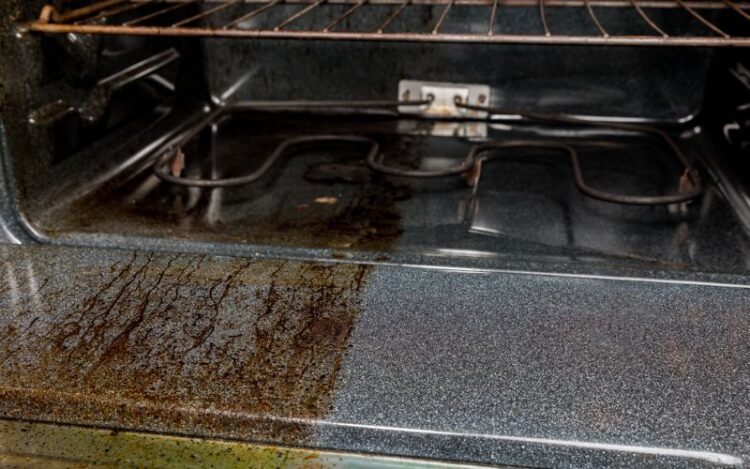What is a Self-Cleaning Oven?
The purpose of a self-cleaning oven is to make the often laborious process of cleaning the oven’s interior more easier. High temperatures during a dedicated cleaning cycle turn food remnants and grease into ash, which may then be wiped away. This cutting-edge function has simplified and improved the way we clean and maintain our ovens.
Benefits of Self-Cleaning Ovens
Self-cleaning ovens increase safety, which is why they are so popular. Cleaning an oven with strong chemicals, which can be toxic if not used properly, is the conventional way. By removing the need for toxic chemicals, self-cleaning ovens provide a less hazardous kitchen.
The self-cleaning function of modern ovens makes cleanup a breeze. Stains and burnt-on residues are reduced to ash by the high-temperature cleaning cycle and can be easily wiped away with a moist cloth or sponge.
A clean oven not only cooks better, but also looks nicer. By eliminating unpleasant odors and stains, self-cleaning ovens help keep your kitchen smelling and appearing fresh.
Different Types of Self-Cleaning Ovens
Continuous-Clean Ovens
Regular use of a continuous-clean oven will help break down and eliminate spills and stains on the oven walls, thanks to the particular porcelain enamel coating. Self-cleaning cycles help maintain the oven clean over time, but they aren’t as effective as manual cleaning.
High Heat Cleaning Method
The most typical approach of self-cleaning utilizes high temperatures. This process takes several hours and requires an oven temperature of at least 900 degrees Fahrenheit (482 degrees Celsius). After the cycle is complete, you may simply wipe away the ash to remove any traces of food or oil.
Steam Cleaning Method
Steam cleaning, wherein water is used to soften and dissolve food remains, is a function of several contemporary ovens. Water is added to the oven, and the resulting steam is used to decompose the soil. When the cycle is finished, simply wipe away the loosened particles using a cloth.
Pyrolytic Cleaning Method
The most cutting-edge and effective self-cleaning ovens use pyrolytic technology. They employ temperatures well above 900 degrees Fahrenheit (482 degrees Celsius) to turn food scraps and grease into ash. When the cooking cycle is complete and the oven has cooled down, the ash can be easily wiped out and the inside will be left clean.
How Long Is a Self-Cleaning Oven Cycle?
Dependent on Type and Model of the Oven
A self-cleaning oven cycle’s length might change from one model to the next. For example, pyrolytic cleaning cycles can go on for 2–6 hours, while high heat cleaning cycles often run 3–4 hours.
An Average Timeframe
The typical self-cleaning cycle for an oven takes roughly 3 hours to complete. The high temperatures required to convert food residue into ash are reached and maintained for this time in the oven.
Maximum Time Limits
To prevent overheating and potential damage, most ovens include built-in safety features that cut short the self-cleaning cycle. Self-cleaning cycles typically have a maximum time limit imposed by the manufacturer that should not be exceeded.
Other Considerations for Your Self-Cleaning Oven Cycle
Variable Cycle Times for Varying Ambient Conditions
The level of debris and grease in your oven can be matched to the cleaning cycle you select on some self-cleaning ovens. The effectiveness of the clean can be maximized by choosing the correct setting.
The oven needs to cool down after the self-cleaning cycle is finished. You can speed up the cooling process and get back to using your oven sooner with the help of the rapid cool-down feature included on some models.
Needs for Adequate Ventilation While in the Cycle
Because of the high temperatures and burning debris, your kitchen may get rather hot and smokey during a self-cleaning session. Open windows or run exhaust fans to disperse stifling heat and stale air.
Precautionary Measures When Run Times are Extended
Do not interrupt the self-cleaning cycle of your oven, even if it seems to be taking longer than usual. To the contrary, keep an eye on the cycle and be patient. If the cycle lasts far longer than the maximum period allowed by the manufacturer, read the handbook or get in touch with tech support.
Variation by Production and Model
It’s crucial to familiarize yourself with the particular instructions supplied in your oven’s user handbook, as the self-cleaning process can vary significantly between models and brands.
Methods to Get Things Done Quicker
Make sure your oven is mostly clean before starting the self-cleaning cycle so that it can finish more quickly. The self-cleaning feature will function better if large food particles and spills are removed manually.
Conclusion
All things considered, self-cleaning ovens are a great investment because they make cooking safer, less time-consuming, and more aesthetically pleasing. Self-cleaning technologies come in many forms, with pyrolytic cleaning being the most comprehensive. Safety features prevent the oven from overheating during the self-cleaning cycle, which typically lasts about 3 hours but might vary depending on the model. The success of the self-cleaning process depends on a number of factors, including ventilation and cooling.
Advantages of a Self-Cleaning Oven
A self-cleaning oven is a smart investment for your time and energy, kitchen safety, and aesthetics. These machines make it easy to solve the age-old problem of cleaning the oven, so you can focus on your culinary creations rather than worrying about lingering odors and stains.

